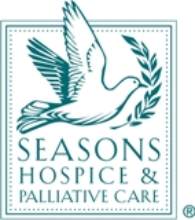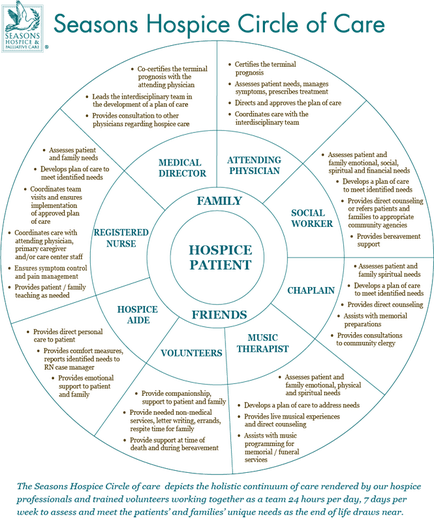
Palliative Care and Hospice is a topic that we have not discussed in our class yet. Palliative care and Hospice are topics that are important to me.I interned at Seasons Hospice for 6 months. I was somewhat hesitant because I had to ultimately face my fears of discussing death and dying . Before interning at Seasons Hospice, I did not discuss death,dying, grief or even loss . I never would like to face my emotions when a close friend or family member passed away. .
Before interning at Seasons Hospice my uncle developed stage 4 lung cancer.
The doctor said that he had about 6 months to live. He actually live for over a year since we found out he was diagnosed with cancer. My uncle lived in California . I only saw him a few times when I was little. My sister ,mom and I live with my uncle for about 2 months when we were 4.My uncle was the type of person that even on his worst days, he would have a positive up beat attitude. He knew that he was sick and he did not want to tell my family. He has hospice in his home during the last months of his life.
What is Hospice?
Hospice is assisting those nearing the end of life and in need of care. The focus is on the patient and the family rather than the disease; the goal is to improve the quality of life that remains. The concept of hospice is based on the needs and wishes of the patent and their family.
Hospice is not a place, a building, or an institution (a frequent misconception). Instead, it's a concept -a collection of ideas and attitudes - about an array of services based on a holistic philosophy of living and dying (Seasons Hospice, 2013).
What is Palliative Care?
Palliative care is comfort care through management of symptoms with encompasses the physical, , social, emotional and spiritual needs of the patient .The goal of Palliative care is to to relieve or soothe the symptoms of patients' diseases or disorders without attempting a cure(Seasons Hospice, 2013).
The History of Hospice
The term “hospice” can be traced back to medieval times when it referred to a place of shelter and rest for weary or ill travelers on a long journey. The name was first applied to specialized care for dying patients by physician Dame Cicely Saunders, who began her work with the terminally ill in 1948 and eventually went on to create the first modern hospice. It was called St. Christopher’s Hospice in a residential suburb of London (National Hospice Organization,2013). http://www.nhpco.org/history-hospice-care.
If you go to the website below they explain the services they provide with links to helpful resources.
www.seasons.org
Before interning at Seasons Hospice my uncle developed stage 4 lung cancer.
The doctor said that he had about 6 months to live. He actually live for over a year since we found out he was diagnosed with cancer. My uncle lived in California . I only saw him a few times when I was little. My sister ,mom and I live with my uncle for about 2 months when we were 4.My uncle was the type of person that even on his worst days, he would have a positive up beat attitude. He knew that he was sick and he did not want to tell my family. He has hospice in his home during the last months of his life.
What is Hospice?
Hospice is assisting those nearing the end of life and in need of care. The focus is on the patient and the family rather than the disease; the goal is to improve the quality of life that remains. The concept of hospice is based on the needs and wishes of the patent and their family.
Hospice is not a place, a building, or an institution (a frequent misconception). Instead, it's a concept -a collection of ideas and attitudes - about an array of services based on a holistic philosophy of living and dying (Seasons Hospice, 2013).
What is Palliative Care?
Palliative care is comfort care through management of symptoms with encompasses the physical, , social, emotional and spiritual needs of the patient .The goal of Palliative care is to to relieve or soothe the symptoms of patients' diseases or disorders without attempting a cure(Seasons Hospice, 2013).
The History of Hospice
The term “hospice” can be traced back to medieval times when it referred to a place of shelter and rest for weary or ill travelers on a long journey. The name was first applied to specialized care for dying patients by physician Dame Cicely Saunders, who began her work with the terminally ill in 1948 and eventually went on to create the first modern hospice. It was called St. Christopher’s Hospice in a residential suburb of London (National Hospice Organization,2013). http://www.nhpco.org/history-hospice-care.
If you go to the website below they explain the services they provide with links to helpful resources.
www.seasons.org
- Seasons Hospice Foundation
- Adult Day Care Finder
- Aging with Dignity / 5 Wishes
- Assisted Living Facility Finder
- The Hospice & Palliative Care Nurses Association
- Jewish Child and Family Services
- Long Term Care Info-National Clearing House
- ShivaConnect
- Skilled Nursing Facility Finder

- There are multiple levels of care for palliative and hospice patients. In end-of-life situations, the roles is to improve the quality of care for the patients and their family members.
- Seasons hospice provides spiritual support, music therapy, pet team volunteer, trained volunteers and interns to assist patients and caregivers, bereavement counseling and support for family members and significant others, consultations 24 hours a day, and regular visits by registered hospice nurses that are specialized in symptom management.
Services
- Our Services
- Open Access
- Palliative Care
- Inpatient Care
- A Touch for All Seasons
- Music Therapy
- Kangaroo Kids
- Spiritual Support
- Social Work
- Bereavement Support
- Volunteering
Kangaroo Kids
Kangaroo Kids is a unique pediatric program dedicated to offering care to children and families who face a life-threatening illness (Seasons Hospice. 2013).
Kangaroo Kids is something I never got the chance to experience . In fact, I ever knew they had this service while interning. Seasons Hospice only had one pediatric patient that received hospice services.From what I have heard , the child was related to a Seasons Hospice employee.
Music Therapy
I had a chance to shadow a few music therapists, and it truly was an experience I will never forget. I witnessed patients who were non-responsive ,open their eyes and respond to the music. I got the chance to meet two adorable couple. They were married at the age of 20, both are in their early 90s ,with no children. The man was receiving hospice services through a nursing home and his wife lived at nursing home as well.She was not on hospice , but she was facing an illness herself. When I walked into the room they responded, but they were really weak and closed their eyes.The man was laying in his bed , and the wife was in a wheelchair next to the bed holding her husbands hand (STRAIGHT OUT OF THE NOTEBOOK). So as the therapist began to play ,both of them opened their eyes, and looked at each other (the man was crying) and they began to sign their songs from back in the day.As soon as the music stopped they did not respond until the music began. I cried after we walked out of their rooms. It is truly a unique experience to witness patients who cannot communicate ,and as soon as a familiar song comes on begin to come to life.
This video is a little long ,but I think it covers a lot of information regarding the differences of palliative care and hospice services and how they help individuals with an illness. I especially like how he mentions people will say "isn't your job sad!" I think that many people say this when I told them I interned at a Hospice agency . I think it depends upon the individual . We all deal with death and dying in our own way , but it is important to help the quality of care with individuals suffering from a mental illness. The people I met while interning, made me look at my own life and how I have taken my family and the people I love for granted.
 RSS Feed
RSS Feed